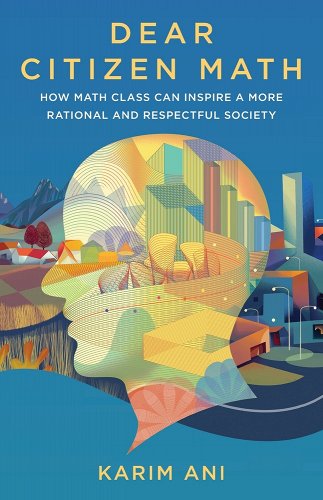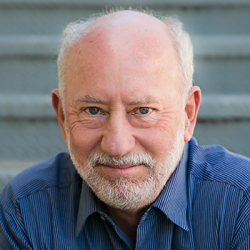
Why do we have to learn this? When will we ever use this? Questions like that often come from students in their math classes. In other subjects too (I heard them as a history teacher) but especially in math. A new book makes a strong case for giving students answers to these questions. It challenges not only how math has been taught but popular notions of what “personalized learning” should be. It also connects with Project Based Learning. And it’s about saving our democracy.
So this book packs a lot into its quick-reading 150 pages!
The book is Dear Citizen Math: How Math Class Can Inspire a More Rational and Respectful Society. The author is Karim Ani, who some of you might know as the founder of Mathalicious. The Buck Institute for Education worked with him back in 2012ish, when some of his super-engaging middle school math “mini-projects” were adapted for PBLU.org, the site where Buck piloted online PBL courses with a project library. He later changed the name of his company to Citizen Math, where you can now find excellent materials for middle and high school math courses.
The Problem With Math Education
Many students are like I was in my high school math classes; willing to trudge through it, but not appreciating “the beauty of math” as my teachers would have liked. It was generally a process of remembering the steps for how to solve a particular problem. Sometimes there would be a “real-world” word problem involving whatever—basketball, cooking, building a house, or the classic “two trains leaving the station…” But they all seemed contrived, just a way to get you to use the procedure you were supposed to learn.
The point was to learn about math, not to learn math by using it. That’s Karim Ali’s basic argument. And that’s also the argument for Project Based Learning—more on that in a minute.
Here’s a taste of Ani’s clear and approachable writing, which this “not a math person” appreciated:
“If students are to react to math differently than they historically have, then we as educators must expand our understanding of what math is and what it means to teach it. We haven’t done this yet. Instead, our strategy for improving math instruction has historically been limited to modifying the same underlying experience that we’ve always provided.”
He goes on to describe some recent strategies for improving math instruction and points out their limitations: Khan Academy (“rote lectures you can rewind”), EngageNY and Illustrative Math (“same problems, lower price”), and Dan Meyer’s “Makeover Math” approach (“math class gets makeup”). All three of these, while valuable in some ways, are just “new versions of the old thing,” Ani says:
“The approach to math instruction that we’ve historically prioritized isn’t bad. It’s just incomplete … Mathematics is larger than we’ve traditionally envisioned. As math educators, we have an opportunity to help students think critically about important issues in the world and to emerge from our classrooms as more curious participants in our society.”
“… we must distinguish between mathematics as a subject to look at and mathematics as a lens to look with. In addition to activities that use an ostensibly ‘real world’ scenario to illustrate some underlying mathematical procedure and concept, we must incorporate ones in which apply those procedures and concepts to learn something new about the world. It isn’t enough to use foul shots as a context for parabolas and milk shakes as a set-up for linear equations. We must also provide students with opportunities to turn the telescope of mathematics around and train it on reality: to use parabolas to debate whether baseball stadiums should be standardized and linear functions to analyze the effects of speeding fines on low-income communities.”
Examples of Using Math to Analyze Real-World Issues
Throughout the book, Karim Ani has mini-chapter vignettes that exemplify the kind of math instruction he’s advocating. Even though he doesn’t use the term, these are very close to Project Based Learning, to my ears. They could easily become the basis for a project if you made sure they had all the elements of Gold Standard PBL, especially Public Product.
For example:
- “Income, Rent, and Homelessness” uses scatterplots and regressions to answer the question, “Should towns and cities recruit high-paying employers?” This activity shows how locating an Amazon headquarters in an area would have both positive and negative effects. (Again, I could see a PBL project in which students address actual local issues of recruiting high-paying employers, and/or write persuasive op-ed pieces on the issue.)
- “Overselling Flights” uses compound probabilities, combinations, and expected value to decide the answer to, “Should airlines oversell their flights?” (In a PBL project, students could connect with people in the airline industry, or propose changes in FAA rules that could help solve the problems passengers have with current practices.)
- “Rating Our Emotions” uses subtracting positive and negative integers and absolute value to explore, “What does an ideal work week look like?” Students examine data gathered from an app where people rate how they are feeling at different times during a week and draw conclusions about what makes us happiest. (A PBL element could be advising people about how to be happy in a blog or other written product, or creating a reflective podcast or video to share publicly.)
There are more, such as one that looks at ““Fake Discounts” used by retailers, and another at health insurance markets. And I loved the stories of Alison Strole, a teacher at Fisher Junior High School in Fishers, Indiana, who was also profiled in a 2019 Ed Week article. Strole uses math to look at real issues in civics. Her students have engaged with their city’s mayor about the cost effectiveness of solar power and a proposed new power plant; analyzed election data to make proposals to Democratic and Republican campaign strategists; and lobbied their school board to consider a later school start time after examining research on adolescent sleep patterns.
Math as Civics Education
As a former high school civics teacher and author of a forthcoming book on teaching civics, these examples really appeal to me. I share Karim Ani’s concerns about the state of our democracy, given current trends in the U.S. He makes a convincing case that the math classroom can be a place to build skills and dispositions for effective citizenship in a healthy democracy: the respectful use of logic and evidence, the recognition of uncertainty when it comes to our society’s complex problems.
I’ll let Karim Ani’s words make this final point:
“As math educators, we are uniquely positioned to restore a commitment to reason. Indeed, we may have more influence over the trajectory of our democracy than anyone else in the country … Every future president, Supreme Court justice, small town mayor, bus driver, and Little League coach: everyone who will determine the future of our country is seated in a classroom today. Almost every issue we encounter in our lives can be better understood through the prism of math, and the classroom is the place to discuss them.”
I strongly recommend this book not only to math educators but to anyone who’s concerned about the state of our nation and world.

